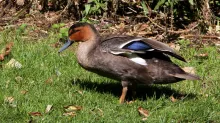
Philippine Duck (Anas luzonica)
Species name
- Dutch name:
- Filippijn eend
- English name:
- Philippine Duck
- German name:
- Philippinenente
- French name:
- Canard des Philippines
- Scientific name:
- Anas luzonica
Scientific classification
- Order:
- Anseriformes
- Family:
- Anatidae
- Onderfamilie:
- Anatinae
- Genus:
- Anas
Description
- Description:
Male:
With its rusty-cinnamon head and bluish-grey bill, the Philippine duck is a rather distinctive bird. The cinnamon colored head is boldly decorated with a black crown and a black stripe through the eye, while the rest of the plumage is brownish-grey. When in flight, a well-defined patch of glossy green on the wing can be clearly seen, which is bordered with black and has a narrow white edge, and the underside of the wing is also white.Female:
As Male, But female is slightly smaller in all aspects by 10 %Juvenile:
Have slightly duller plumage than that of adults.
- Behaviour:
Usually found as pairs or in small groups, but sometimes in larger flocks of 100-200 birds. Pair-bonds may be strong longer lasting rather than seasonal.
Standard Measurements
- Body Length (cm):
- The male (drake) of the Philippine Duck measures approximately 48-58 centimeters. The female measures approximately 48-58 centimeters.
- Body Weight (grams):
- The male will weight about 800-980 gram. The female will weight about 725-820 gram.
The weight is notoriously variable and can only be used as indication!
- Note:
Dabbling Ducks are generally hardy, easy to maintain and easy to breed. Shelter may be required by some of the smaller species in winter. They should be provided with cover (including marginal pond cover) and loafing areas as well as water. A pen which is 50% water is suggested. The water may be shallow (i.e. no more than two feet deep is required), and muddy areas for dabbling in are also appreciated. These ducks are generally good in mixed collections, although the smaller and quieter species may be bullied. Territorial disputes between ducks of the same species may be avoided by keeping only one pair of each species in an enclosure, unless the area is very large. For a single pair of ducks a pen are of 50 to 100 square metres, depending on the size of duck, should be provided.
A diet based on wheat and pellets is suggested, with maintenance pellets changed to breeders pellets for the breeding season. Bread and greenfood are also appreciated. Grit should always be available, with soluble grit (e.g. oystershell grit) as a calcium source when breeding.
Most species are ground nesters and both close ground cover and ground level nest boxes should be provided. Hand-rearing is generally preferred, as these ducks are generally poor parents in captive conditions, particularly in enclosures shared with other waterfowl. These ducks are prone to hybridization, particularly with closely related species, which should be kept apart from one another.
Philippine ducks are fairly winter-hardy and easy to manage. The enclosure should provide water, loafing areas and cover. They are suitable for mixed collections, although there may be problems with drake Mallard (Anas platyrhynchos) attempting to pair with ducks. Feed as other dabbling-ducks, with grain and pellets.
These ducks are easily bred. They may nest in natural close ground cover, ground level or raised nest box, shelters or baskets, eggs laid from April to June. The ducklings are straightforward to rear. A duck may rear two broods in one season; starter crumbs supplemented with duckweed and finely chopped grass suggested.
Prone to hybridisation within the '"mallard" group; hybrids reported with Mallard (Anas platyrhynchos) and Pacific black duck (Anas superciliosa).
- Breeding:
- The female Philippine Duck usually lays from 8-12 pale green eggs and incubates them for 25-26 days.
- Artificial incubating:
The ideal relative humidity for incubating most waterfowl eggs is 55% (ground nesters) and 40% (cavity nesters). The temperature is usually 37.4°C. Set ventilation as recommended by the incubator manufacturer. Eggs must be turned, either automatically or by hand, a minimum of 4 times a day. As the duckling develops there is a loss of water from the egg and the air sac gets bigger. In normal development of an egg with a 25-26 days incubation, the air sac occupies about a third of it three days earlier. Cleanliness is vital and ideally eggs should be moved to a separate hatcher at this point, where the humidity should be increased to 65% and even higher once they have pipped internally.
- Bird banding:
- Recommended closed leg band ring size for the Philippine Duck is 11 mm.The leg band ring can only be applied on a young dabbling duck at around 12-14 days old.
- It doesn't matter what leg that you band, but it's good to have a consistent system. Suggested: Left leg = Female, Right leg = Male
- Maintenance food:
-





Lundi Regular with a protein content of 20%, valuable Spirulina and high-quality by-products is optimally balanced in its composition maintenance food for water ornamental fowl of all kinds. Especially green teal and Whistling ducks that are not dependent on a very high protein content, are well supplied.
Lundi Regular contains all the minerals and vitamins in full form that are important for the animals. Therefore also suitable as breeding food.





Floating full food for all sea ducks, green ducks, eider ducks and geese, especially in the moulting and breeding phase ideally suited. Packed with wholesome raw materials, natural vitamins and trace elements, this performance food with a protein content of 30% forms the basis for lifelong vitality.



